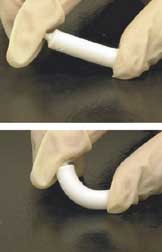
Comparative study of different nitrogen-containing plasma modifications applied on 3D porous PCL scaffolds and 2D PCL films
Sign Up to like & getrecommendations! Published in 2020 at "Applied Surface Science"
DOI: 10.1016/j.apsusc.2020.146067
Abstract: Abstract Additive manufacturing of 3D-scaffolds and surface modification of 2D-substrates using nitrogen-containing plasmas have separately advanced the tissue engineering field for their cyto-responsive topographical and chemical features. However, their synergistic implementation remains largely unsuccessful because… read more here.
Keywords: nitrogen; surface; nitrogen containing; plasma modifications ... See more keywords

Insights into the biomechanical properties of plasma treated 3D printed PCL scaffolds decorated with gold nanoparticles
Sign Up to like & getrecommendations! Published in 2021 at "Composites Science and Technology"
DOI: 10.1016/j.compscitech.2020.108544
Abstract: Abstract Tissue engineered constructs having desired biomimetic and mechanical properties emerged due to the complexities involved in conventional skin grafting. They facilitate tissue regeneration without compromising mechanical properties. Herein, we report the fabrication of polycaprolactone… read more here.
Keywords: printed pcl; gold nanoparticles; surface; pcl ... See more keywords

Comparison of 3D-printed mesoporous calcium silicate/polycaprolactone and mesoporous Bioacive glass/polycaprolactone scaffolds for bone regeneration
Sign Up to like & getrecommendations! Published in 2019 at "Microporous and Mesoporous Materials"
DOI: 10.1016/j.micromeso.2019.01.007
Abstract: Abstract Mesoporous calcium silicate (MCS) and mesoporeous bioactive glass (MBG) are important components of silicon-based bioceramics and have been widely investigated. However, few studies were specifically focused on the differences between MCS and MBG scaffolds… read more here.
Keywords: bone regeneration; pcl scaffolds; pcl; polycaprolactone ... See more keywords

Recreating the Trabecular Outflow Tissue on Implantable, Micropatterned, Ultrathin, Porous Polycaprolactone Scaffolds
Sign Up to like & getrecommendations! Published in 2023 at "Bioengineering"
DOI: 10.3390/bioengineering10060679
Abstract: Glaucoma, where increased intraocular pressure (IOP) leads to damage to the optic nerve and loss of sight, is amongst the foremost causes of irreversible blindness worldwide. In primary open angle glaucoma, the increased IOP is… read more here.
Keywords: ultrathin porous; outflow tissue; htm; pcl scaffolds ... See more keywords

3D-Printed PCL Scaffolds Combined with Juglone for Skin Tissue Engineering
Sign Up to like & getrecommendations! Published in 2022 at "Bioengineering"
DOI: 10.3390/bioengineering9090427
Abstract: Skin diseases are commonly treated with antihistamines, antibiotics, laser therapy, topical medications, local vitamins, or steroids. Since conventional treatments for wound healing (skin allografts, amnion, xenografts, etc.) have disadvantages such as antigenicity of the donor… read more here.
Keywords: juglone; tissue engineering; printed pcl; pcl scaffolds ... See more keywords

Influence of 3D Printing Parameters on the Mechanical Stability of PCL Scaffolds and the Proliferation Behavior of Bone Cells
Sign Up to like & getrecommendations! Published in 2022 at "Materials"
DOI: 10.3390/ma15062091
Abstract: Introduction The use of scaffolds in tissue engineering is becoming increasingly important as solutions need to be found for the problem of preserving human tissue, such as bone or cartilage. In this work, scaffolds were… read more here.
Keywords: pcl scaffolds; bone; mechanical stability; geometry ... See more keywords

Electrospinning PCL Scaffolds Manufacture for Three-Dimensional Breast Cancer Cell Culture
Sign Up to like & getrecommendations! Published in 2017 at "Polymers"
DOI: 10.3390/polym9080328
Abstract: In vitro cell culture is traditionally performed within two-dimensional (2D) environments, providing a quick and cheap way to study cell properties in a laboratory. However, 2D systems differ from the in vivo environment and may… read more here.
Keywords: culture; cell; pcl scaffolds; breast cancer ... See more keywords